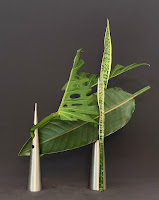Hello all,
As many of you will be aware, our chapter is celebrating our 60th Anniversary this year with various events planned, one of which is a demonstration by our special guest, Master Instructor, Kosa Nishiyama. Details in the flyer, above. It is a rare treat to see a demonstration by such an accomplished master instructor outside of Japan, so I hope you will avail yourselves of this opportunity. We're very excited and would love it if you would join us. Also, tell your friends.
At the recent Sogetsu meeting I ran the workshop with a double theme - 'With Leaves Only' and 'Using Two or More Containers'.
In the lesson 'With Leaves Only', we are required to use single leaves not ones attached to branches and to use at least two different types of leaves. Also, thin leaves, such as dietes or spear grass are considered lines not leaves.
As for 'A Number of Containers', I feel that it is not advisable to fit one container into another because that merely creates one new container. So I advised the attendees to avoid it.
I had one arrangement set up when the meeting began and demonstrated another three. The photograph, above is of me and my three demonstration pieces.
The photograph, below, is of the arrangement already set up. I used Gymea Leaf, 3 New Zealand flax leaves, bird's nest fern and fatsia japonica leaf in two ceramic suibans.
All the photographs of the demonstration are courtesy of Christopher James.
REUSING MATERIALSI'm always loathe to discard any material that may still be useful. Often, it will be reused but there are, also, times that it will sit in the bucket until it decomposes and, lets face it, start to smell. Below are four examples of materials that have contributed to a new arrangement.
I had used the trimmed conifer in a different arrangement originally but when I dismantled it two weeks later, the conifer was still in great condition. So, I cut it down and created a new arrangement of mass and line with the addition of an arum lily.
The sansevieria leaves were a part of my demonstration piece at our recent workshop. This material can last a very long time, even out of water. To my new arrangement, I added a third leaf and brightly coloured camelias in a ceramic container, which I made at the Sogetsu kiln.
The bare leafed muehlenbeckia is very versatile as it does not need to be in water. I think the two arrangements are quite self explanatory.
I split the variegated New Zealand flax leaves and created an arrangement on the theme of 'The Shape of the Container' using my self made, ceramic container.
Mary's class theme was 'Arrangements with Plants on a Wall'. She used a dried branch with aspidistra leaves and camellias.
And one more thing. In my last post I attributed Akemi's arrangement to Cymbie. I apologize to both the girls.Bye for now,
Emily













































